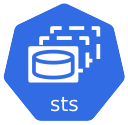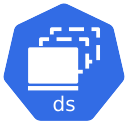StatefulSets / DaemonSet


Useful Links
Architecture

Detailed Description
KubernetesNext to deployments, there are also DeploymentsStatefulSetsserveand asDaemonSets ain blueprintKubernetes, designed for runningspecific your application in a cluster. Building on ReplicaSets, they ensure your application remains in the desired state by maintaining the defined numbertypes of instances.workloads.
ReplicaSets take care of the following:StatefulSets:
EnsuringthePurpose:desiredUsednumberforofapplications that require stable, persistent storage and consistent network identities (like databases or messaging systems).-
Key Features:- Pods are
alwayscreatedrunningsequentially with unique, predictable names (e.g.,my-app-0,my-app-1). ReplacingEachfailedPodPodsgetsautomaticallyits own persistent storage (via Persistent Volume Claims) that remains even if the Pod is deleted.- Useful for applications that need to
maintainkeepthetrackspecifiedofreplicastheir state or require ordered scaling.
- Pods are
On top of that, a Deployment adds features, such as:DaemonSets:
AutomaticallyrollingPurpose:outEnsurenewthatversionsa copy ofyour applicationRolling back toapreviousPodversionrunsifonsomethingeverygoesnodewrongManaging updates with strategies like rolling updates(orrecreatingspecificPods
When a deployment in Kubernetes performs an upgrade (for example, if you change the image or other pod specifications), a rolling upgrade strategy is created by default. This manages the ReplicaSets to ensure minimal downtime and meet the constraints set by maxUnavailable and maxSurge.
The Deployment maintains a current ReplicaSet (for the existing pods) and creates a new ReplicaSet for the updated pods.
During the update, pods are gradually scaled downnodes) in the oldcluster.
ReplicaSet
revisionHistoryLimitKey Features The Number of old replicas to retain for rollback.
strategy Defines the deployment strategy, Default RollingUpdate or Recreate.
Recreate: All existingPods aredestryoedautomaticallybeforeaddedneworonesremoved when nodes arecreatedadded or removed.RollingUpdate:CommonlyUpdatesusedPodsforinsystem-levelaservicesrollinglikeupdatelogging,fashionmonitoring, or networking agents (maxUnavailable;e.g.,maxUnavailable)Fluentd, Prometheus Node Exporter).- Each node gets exactly one Pod.
Example: If there are 4 replicas in a Deployment and maxUnavailable is set to 1:
At most, 1 pod can be unavailable during the update.Kubernetes will ensure at least 3 pods (old or new) are running at any given time.
maxSurge The maximum number of extra pods that can be created beyond the desired replicas during the update. Default: 25% Determines how many new pods can be created during the update to replace old pods.
Example: If there are 4 replicas in a Deployment and maxSurge=1:
Up to 5 pods (4 original + 1 new) can be running at once during the update.
Command Reference Guide
Remeber to use dry-run and tee to check the configuration of each command first.
--dry-run=client -o yaml | tee nginx-deployment.yaml
Create a ReplicaSet using a YAML file (declarative method)
nginx-replicaset.yaml
apiVersion: apps/v1
kind: ReplicaSet
metadata:
name: nginx-replicaset
spec:
replicas: 3
selector:
matchLabels:
app: nginx
template:
metadata:
labels:
app: nginx
spec:
containers:
- name: nginx
image: nginxdemos/hello
ports:
- containerPort: 80
# Apply replicaset
kubectl apply -f nginx-replicaset.yaml
# Get ReplicaSet informatoin
kubectl get replicaset nginx-replicaset -o wide
# Get detailed ReplicaSet information
kubectl describe replicaset/nginx-replicaset
# Check the current Pods running
kubectl get pods
# Delete a Pod of the ReplicaSet
FIRST_POD=$(kubectl get pods -l app=nginx -o jsonpath='{.items[0].metadata.name}')
kubectl delete pod $FIRST_POD
# Recheck running Pods
kubectl get pods
# Change image in yaml to nginxdemos/hello:v0.2 and apply replicaset again
kubectl apply -f nginx-replicaset.yaml
# You will encounter that the replicaset was updated - but the pods are still using the old image
kubectl describe replicaset/nginx-replicaset
kubectl describe pod/<podname>
# You have to kill and recreate the pods, so the new ones will be created with the new image. (see Hint section)
FIRST_POD=$(kubectl get pods -l app=nginx -o jsonpath='{.items[0].metadata.name}')
kubectl scale rs nginx-replicaset --replicas=0
kubectl scale rs nginx-replicaset --replicas=3
kubectl describe pod/$FIRST_POD
Create a Deplyoment (imperative method)
nginx-deployment.yaml
apiVersion: apps/v1
kind: Deployment
metadata:
labels:
app: nginx-deployment
name: nginx-deployment
spec:
replicas: 25
selector:
matchLabels:
app: nginx-deployment
strategy:
rollingUpdate:
maxSurge: 25%
maxUnavailable: 25%
type: RollingUpdate
template:
metadata:
creationTimestamp: null
labels:
app: nginx-deployment
spec:
containers:
- image: nginxdemos/hello:0.4
imagePullPolicy: Always
name: hello
ports:
- containerPort: 80
protocol: TCP
resources: {}
status: {}
# Create nginx deployment with the default of one replica
kubectl create deployment nginx-deployment --image=nginxdemos/hello --port=80
# Create nginx deployment with three replicas
kubectl create deployment nginx-deployment --image=nginxdemos/hello --port=80 --replicas=3
# Check deployment
kubectl get deployment -o wide
# Get detailed deployment information
kubectl describe deployment
# Get ReplicaSet information created by deployment
kubectl get replicasets -o wide
# Get History for deployment
kubectl rollout history deployment/nginx-deployment
# Annotate inital history entry
kubectl annotate deployment/nginx-deployment kubernetes.io/change-cause="init nginx deployment"
kubectl rollout history deployment/nginx-deployment
# Scale up/down deployment (scale is not changing history)
kubectl scale deployment/nginx-deployment --replicas=2; watch kubectl get pods -o wide
kubectl scale deployment/nginx-deployment --replicas=20; watch kubectl get pods -o wide
# Run update and rollback
FIRST_POD=$(kubectl get pods -l app=nginx-deployment -o jsonpath='{.items[0].metadata.name}')
# Check image name
kubectl get pod $FIRST_POD -o jsonpath='{.spec.containers[0]}'}
kubectl get deployment/nginx-deployment -o yaml > nginx-deployment.yaml
# check Update yaml modifications under code section
kubectl apply -f nginx-deployment.yaml && kubectl rollout status deployment/nginx-deployment
kubectl annotate deployment/nginx-deployment kubernetes.io/change-cause="update new version"
kubectl rollout history deployment/nginx-deployment
# Recheck image name after update
kubectl get pod $FIRST_POD -o jsonpath='{.spec.containers[0]}'}
# Check replicaset
kubectl get replicaset
# ROllback to previouse revision
kubectl rollout undo deployment/nginx-deployment --to-revision=1 && kubectl rollout status deployment/nginx-deployment
kubectl rollout history deployment/nginx-deployment
# check pod image, as it was reverted to old revision
FIRST_POD=$(kubectl get pods -l app=nginx-deployment -o jsonpath='{.items[0].metadata.name}')
kubectl get pod $FIRST_POD -o jsonpath='{.spec.containers[0]}'}
# Run into failed state (change image in yaml to nginxdemos/hello:5.1)
kubectl apply -f nginx-deployment.yaml && kubectl rollout status deployment/nginx-deployment
kubectl annotate deployment/nginx-deployment kubernetes.io/change-cause="failed version"
kubectl rollout history deployment/nginx-deployment
kubectl rollout undo deployment/nginx-deployment --to-revision=3 && kubectl rollout status deployment/nginx-deployment
# check pod image, as it was reverted to healthy revision
FIRST_POD=$(kubectl get pods -l app=nginx-deployment -o jsonpath='{.items[0].metadata.name}')
kubectl get pod $FIRST_POD -o jsonpath='{.spec.containers[0]}'}
kubectl rollout history deployment/nginx-deployment
# Pause from deplyoment
kubectl rollout pause deployment nginx-deployment
kubectl set image deployment/nginx-deployment nginx=nginx:1.22
kubectl get deployment nginx-deployment -o yaml | grep paused
kubectl rollout resume deployment nginx-deployment
kubectl rollout status deployment nginx-deployment
# Delete deployment
kubectl delete deployment/nginx-deployment
Hints
Deployments manage ReplicaSets, primarily due to historical reasons. There is no practical need to manually create ReplicaSets (or previously, ReplicationControllers), as Deployments, built on top of ReplicaSets, offer a more user-friendly and feature-rich abstraction for managing the application lifecycle, including replication, updates, and rollbacks.
ReplicaSets do not support auto updates. As long as required number of pods exist matching the selector labels, replicaset's jobs is done.
When a rollback is applied to a Deployment, Kubernetes creates a new history revision for the rollback. It doesn’t simply go back to an old revision but treats the rollback as a new change. This means the rollback gets its own revision number, while the previous revisions remain saved. This helps you keep track of all changes, including rollbacks.
